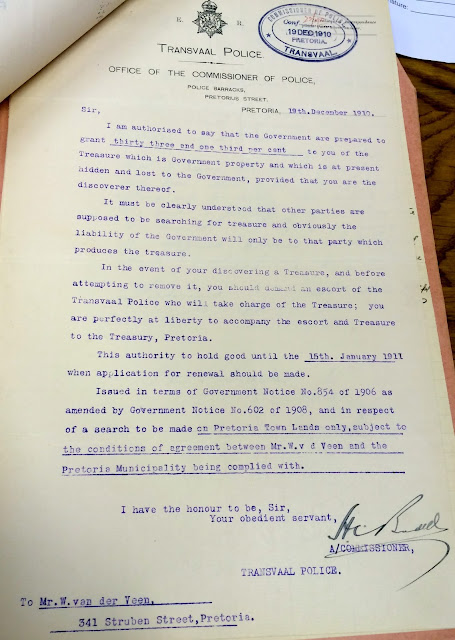My jaw dropped when I was reading one of the emails I received from Alta Bekker with research information on Arend Johannes van der Veen, the Dutch settler to South Africa.
Manslaughter.
Hard drinking.
Suicide.
He had made the hugely challenging move from Europe to Port Natal, and then onto the Transvaal. He brought his children with him and they in turn settled, were builders and farmers, the family grew.
The building firm; Van der Veen, AJ & Zonen, were involved in the building of Church Square.
The building firm; Van der Veen, AJ & Zonen, were involved in the building of Church Square.
Here are some of the insights Alta sent me:
According to REX-03 p 136 in 1862 they started with the restoration and repairs to the old pastoral homestead.
 The home was originally built for president [then still commandant-general] Pretorius but he never lived in it.
The home was originally built for president [then still commandant-general] Pretorius but he never lived in it.
It became the parish of the Chruch Square church and it was of the 1st home on the square and minister Begeman moved in at the end of 1862 or early 1863.
Before he moved in renovations were done by the building contractors A.J. van der Veen en Zonen.
In 1872 Arend is convicted of manslaughter (Misdaad van doodslag):
DEN DOOD VAN F DE LILLE RADIER TEN GEVOLGE EENER VERWONDING AAN HET HOOFD HEM TOEGEBRAGT DOOR DEN CIPIER (Jailer in English) VAN HET GEVANGENHUIS TE PRETORIA op 26/3/1872 (SPR122-01 and -02; SPR199).
So I went looking for the references mentioned above, two SPR documents at the National Archives. Letters from 1872 and in Dutch!I am waiting for these letter to be translated.
And then sadly and finally, a decade later:
“DETERMINED SUICIDE – Last Thursday morning (23 Feb 1882) it was discovered that old Mr AJ van der Veen, an old resident of Pretoria, formerly gaoler here, had committed suicide.
From an enquiry instituted by the authorities, it appeared that he was missed from his residence on Wednesday (22 Feb 1882) evening.
Search was made by his relatives and late in the night his body was found in the small guard-house to the left of the Poort, with his throat-cut.
On examination an old and very blunt razor was found near the body, his walking-stick was standing alongside the wall, his coat and necktie had been taken off and his shirt front was unbuttoned. Life must have been extinct for some time when the body was found.
The deceased was about 73 years of age and is reported as having been a hard drinker lately. It appears that he had made an attempt on his life on Tuesday (21 Feb 1882) evening, but this was considered as only a drunken freak.”
Post script:
‘De Volkstem’/’Die Volkstem’ was a Dutch and Afrikaans newspaper that started to circulate in Pretoria in August of 1873, whereafter it was temporarily unpublished during the Second War of Liberation. Publications in the English language only emerged after 1880, but these did not endure very long. ‘De Volkstem’ continued its media life after the war in Pretoria until 1949, but then moved its audience to Johannesburg for a brief period, only to end its existence in 1950 for good.



















